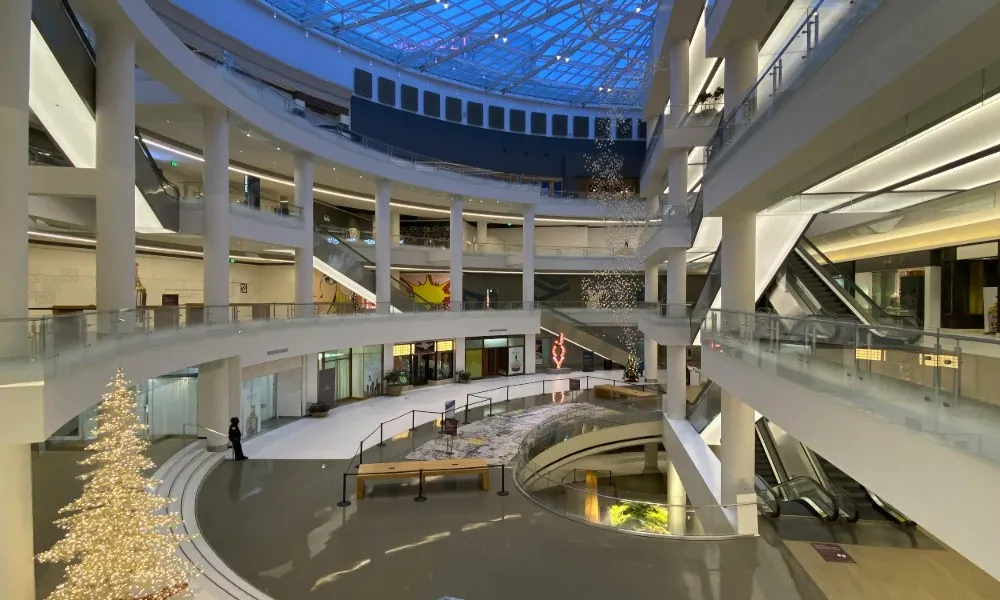Before riots and during pandemic, and since these have stopped or quieted down, my husband and I have been drawn to Seattle’s downtown and the lively evolutions that take place within its urbanity.
We have always been drawn to Seattle’s downtown — celebrating and patronizing the establishments, going to theater, to museums, to Nordstrom, to doctor’s appointments, to meet friends for meals. The new and expansive Convention Center is complete. The Cannonball arts center, between downtown and Seattle Center, is set to open in 2025 and is getting press. Now comes word that the Coliseum Theater (once a Banana Republic) at Fifth and Pike is being converted to an art space.
So now it is time to push for a major downtown cultural center. A few years ago, I suggested that the historic Macy’s building with its 80,000-square-foot floor plates and resting atop a train station, was a pivotal place of potential for a cultural center. But then, at the same time, the sparkly Pacific Place was in transition from its original mix of upscale shops, restaurants, and movie theaters. This newer structure comes equipped with skylight and double-pane windows, contemporary building systems, a generous basement parking garage, large atrium, strong transit connections, and a layout and location that would set up perfectly as a cultural center.
We need a downtown cultural center similar to the famous Chicago Cultural Center, fashioned out of the grand former library, free, and just across the street from Millennium Park. It would be a place where tourists and residents can get an introduction to the multi-cultural richness that is scattered throughout the city and region, and also get information and access to resources.
The now-closed Barnes and Noble bookstore basement space at Pacific Place is ideal for just such a tourist hub. That space sits directly and visibly adjacent to the busy Pine Street corridor, and encompasses two internal floors with escalators and plumbing that could be put to perfect use as a tourist center and café/gathering space.
Upstairs, visitors could sample various cultural offerings, helped out by the movie-theater spaces on the top floor. People could shop, eat, and see shows there, as well as getting tips and tickets for other shows in town. Retail would remain in a public-private symbiosis as has proved successful in Chicago, a vibrant arts city.
There could be exhibits and pop-up shops for cultural entities as well as office space, equipment, staff, and assembly areas. Restaurants and cafes can be locations for weekend music events to bring in a young crowd of local and international socializers. There can be a kid’s learning lab with classrooms and exhibit spaces, and a senior center with the same.
The floor plan of this building takes up an entire city block and rises to seven stories with a multi-story, 1,200-car underground garage and a dramatic atrium. As an architect I have drawn plans for these uses in this building. This spacious, accommodating structure is just waiting for the city and the owners to shake hands and work together.
Discover more from Post Alley
Subscribe to get the latest posts sent to your email.

With two other “cultural” spaces in advance planning or soon to open, exactly who who, what, and for whom (locals, paid audiences, tourists, culturally specific groups, children, seniors, artist spaces?) would fill such an enormous area? We’re a big town but other cultural groups are still struggling from post-covid blues. How much more can the city logically support, especially when suburban crowds get drawn to more local resources?
There is actually a third cultural space in planning: The Lusty Lady building on First Avenue across from the Seattle Art Museum. It seems destined to by a museum for visual art. And there may be a new, large venue for big shows. Central question: will new arts facilities help with the downtown rebound, especially since they are mostly closed in the daytime.
Mindy
Great idea. Maybe we should also consider an education use. Either k12 schools or university use. The stores could be class rooms.
It has a huge parking lot paid for by us. The parking costs are too high to attract people downtown. Why doesn’t anyone consider this?
And in the meantime, Cornish College is poised to sell their original building on Roy Street — many alumni are wishing someone with pockets would buy it for a performing arts space.
As Spider K points out above, this is a lot of real estate that will need support.
We need a K-8 Public School Downtown, with a conversion perhaps funded by philanthropy. Call it Our Children Pledge School. Convert nearby empty commercial real estate to housing for teachers, so they don’t have to commute from Kent, unless they want to.
This is a great idea. Cultural centers attract patrons of thexarts as well as the curious. More than one arts center downtown will prove beneficial for all. It’s bought and paid for already. Just do it!